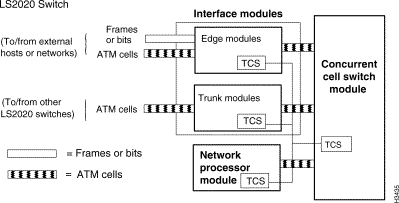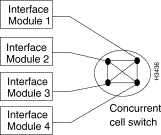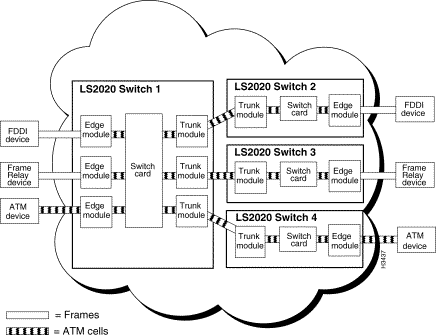|
|

This chapter introduces the LightStream 2020 (LS2020) multiservice enterprise ATM switch. It describes some of the key features of the switch and its structure.
The LS2020 switch is a powerful backbone enterprise ATM switch for local and wide area networks. As an integral part of Cisco product offerings, it has premises capabilities in both ATM and fast packet switching to handle frame relay, circuit emulation, and LAN traffic interfaces. In addition to its ATM capabilities, the LS2020 switch provides FDDI and Ethernet switching that can be easily converted to ATM. The LS2020 network creates a mission-critical enterprise backbone network that provides flexible cost-effective allocation of bandwidth, guaranteed quality of service for all applications, interoperability with past and future devices, and scalability for future applications.
The LS2020 switch is fully compliant with Cisco's family of internetworking products and can be combined with the LightStream 100 and Cisco ATM NIC cards to form an end-to-end ATM network. With the LS2020 and other Cisco internetworking products, you can have end-to-end network solutions no matter what type of internetworking technology you select.
Advances in computers and communications during the past several years have begun to overburden existing network systems and technologies. For example, today's network link speeds continue to grow. In the 1970s, 1.2 kilobits per seconds (kbps) was considered normal speed and 9.6 kbps was considered high speed. In the 1990s, networks using fiber optic technology are pushing speeds of 100 megabits per second (Mbps) and significant speed increases are expected in the future. Also, widespread use of applications that demand large amounts of data have overburdened existing LAN/WAN technology. These applications include distributed supercomputing, high-resolution graphics (CAD/CAM, imaging, and so on), scientific visualization, network-based client/server computing, and distributed file access.
Such advances have created the need for new network architectures and infrastructures that provide higher throughput, more usable bandwidth, and a broader diversity of services.The LS2020 switch was designed with these specific needs in mind.
In addition to basing the LS2020 switch on ATM technology, there are a number of features that make the LS2020 switch a reliable, cost-effective device that provides high-speed, broadband, open networking to many different applications.
To achieve the high throughput needed to make the LS2020 switch operate effectively, most of the switching functions are performed in hardware and firmware. The hardware and firmware operate much faster than software.
Processing tasks for the LS2020 switch have been divided into three classes based on the speed required for each particular task. Line card hardware and firmware perform functions that must be completed in 10s of microseconds or less, such as traffic policing and cell forwarding.Each line card includes a line card control processor that handles the more complex tasks that must be completed in 10s of milliseconds or less, such as interface management, error handling and line up/down protocol processing. Network processor software performs functions that can be completed in more than 10s of milliseconds, such as cell processing and servicing network management requests.
Today's networks feature a wide variety of applications, each with its own performance requirements. One application may need a level of service where cell delay variation must be minimized (for example, voice). Another application may require service that is more cost-effective, but not as delay-sensitive. The LS2020 switch optimizes application performance by providing you with types of service that are right for each application.
LS2020 switches provide cost savings by minimizing the amount of transmission bandwidth needed from carriers. The extent to which an ATM switch lowers carrier costs depends primarily on the switch's congestion avoidance strategy. The LS2020 allows very high line utilization while retaining buffer contract guarantee.
The LS2020 switch uses ControlStream, a proactive congestion avoidance mechanism that manages congestion by controlling traffic at the edges of the network. When an LS2020 network detects congestion, the sources of the congestion are identified and controlled individually based on their service guarantees. Congestion is removed at the source, link use is maximized, and mission-critical service is maintained.
The LS2020 switch provides mission-critical networking, including:
You manage the network using a Sun SPARCstation running StreamView, an SNMP-based network management system. The LS2020 network uses SNMP as its management protocol and is compatible with various SNMP-based management systems. StreamView lets you monitor, control, and configure your LS2020 network. You are provided with a graphical representation of your managed objects and a mouse-driven point and click interface.
In addition to StreamView, you may choose to run HP OpenView management software, from Hewlett-Packard, or another network management system that is SNMP-compatible. Many management tasks can also be performed using a simple command line interface (CLI) from a terminal attached to the console port of an LS2020 node.
For more details on network management, see the "Network Management Tools" section in the "Network Management" chapter.
An LS2020 network provides a very clear migration path to ATM. The LS2020 switch is designed to let you easily migrate to ATM using your existing equipment. The switch provides services that make it backward compatible with any current equipment passing constant bit rate (CBR) traffic, Ethernet, FDDI, high-level data link control (HDLC), synchronous data link control (SDLC), or frame relay frames. The LS2020 switch can accept this traffic from an external device, convert it to ATM cells, and pass it through the network.
The LS2020 switch also accepts ATM cells from an external device and passes those through the network. It provides services that let it interface with equipment that supports ATM user-network interfaces (UNI) and SONET interfaces. As more ATM devices become available on the market, you can add them to your network and pass ATM traffic while still using your existing equipment.
Because of the need of greater integration, an LS2020 network offers various types of service to carry traffic over the network. These services include:
The LS2020 also offers VirtualStream, a LAN internetworking feature that lets you do the following:
The LS2020 switch is based on industry standards allowing it to interoperate with standards-based, high-speed network devices. The LS2020 switch adheres to the ATM specifications being developed by ITU-T, ANSI, and the ATM Forum. The LS2020 switch also adheres to the SNMP specification enabling it to be managed by any SNMP-compatible network management system.
The LS2020 switch conforms to all of the standards listed in Table 2-1; however, not every detail of each standard has been implemented.
| Document Number | Title |
|---|---|
| ANSI T1.403 | ATM UNI DS1 interface |
| ANSI T1.618 (LAP-F) and ITU-T Q. 922 Annex A | Frame Relay (for Frame Format) |
| ANSI T1.617 Annex D and ITU-T Q.933 Annex D | Frame Relay (for LMI1 and PVC management) |
| ANSI T1.627-1993 B-ISDN | ATM Layer Functionality and Specification |
| ANSI T1.606 and ITUT-T I.233 | Frame Relay (for UNI) |
| ANSI X3T9.5 | FDDI Standard for I/O interfaces |
| ATM Forum UNI Specification V2.0, 3.0, 3.1 | ATM UNI Service |
| FRF.2 | Frame Relay (for NNI) |
| IEEE802.1g | Translation Bridging |
| IEEE802.3 | Ethernet |
| IEEE802.3 | Fiber Ethernet (for 10Base-FL) |
| IEEE802.1d | Spanning Tree Protocol |
| ATMF94-003397 | Circuit Emulation Service |
| Internet RFC #1157 | Simple Network Management Protocol (for network management) |
| Internet RFC #1213 | Management Information Base (MIB-II) |
| Internet RFC #1248 | Ethernet Interface Type MIB |
| Internet RFC #1406 | DS1/E1 Interface Type MIB |
| Internet RFC #1407 | DS3/E3 Interface Type MIB |
| Internet RFC #1493 | Definition of Managed Objects for Bridges |
| Internet RFC #1512 | FDDI Interface Type MIB |
| Internet RFC #1595 | SONET Interface Type MIB |
| ITU-T I.150 | B-ISDN Asynchronous Transfer Mode Functional Characteristics |
| ITU-T I.361 | B-ISDN ATM Layer Specification |
| ITU-T I.311 | B-ISDN General Network Aspects |
| ITU-T I.363
| B-ISDN ATM Adaptation Layer (AAL) Specification (AAL 5 only) |
| ITU-T I.371
| Traffic Control and Congestion Control in B-ISDN |
1The LS2020 product supports three LMI options: ANSI T1.617 Annex D, the original Frame Relay Consortium (now known as FR Forum) LMI version, and frame relay interface with no LMI. | |
Compliance with standards ensures that LS2020 switches can interoperate with a wide range of network devices.
Figure 2-1 shows the key components in an LS2020 switch.

The major elements in the LS2020 architecture are
Together, these modules provide the functions needed to receive frames, bits, or ATM cells from external devices and transfer ATM cells across a network.
The following sections detail each of these components.
In an LS2020 switch, the concurrent cell switch module consists of a switch card plus a console/modem assembly. The switch card contains the concurrent cell switch, which interconnects all interface and NP modules. The console/modem assembly provides the physical interfaces for the console and modem ports on the switch card.
Figure 2-2 illustrates the concurrent switch architecture.

In a concurrent cell switch architecture, each interface module or NP module is interconnected with every other interface module or NP module through a concurrent cell switch that allows multiple transactions to occur between these devices simultaneously.
The use of many parallel paths allows the aggregate throughput of an LS2020 switch to be extremely high, without requiring that the speed of each individual interface match the aggregate speed.
The concurrent cell switch on the switch card has 10 input ports and 10 output ports. Each output port has two channels to reduce the probability that data passing through the switch will be blocked. The total bandwidth on each port is 200 Mbps full duplex. Allowing for cell headers and switch contention (more than two switch input lines destined for the same output), this provides a sustained payload throughput of approximately 160 Mbps full duplex. All switch ports can pass traffic simultaneously resulting in a peak transfer rate of 2 gigabits (Gbps) and an aggregate sustained payload throughput of 1.6 Gbps.
The network processor (NP) module contains an NP card plus an NP access card.The NP module supports RouteStream, a highly sophisticated distributed network routing protocol.
The NP access card houses an Ethernet interface for the NP module. This makes it possible for a network management station to attach to the LS2020 network that has no LAN interface modules. Each NP module also has a disk assembly associated with it. The disk assembly contains a floppy disk drive and a hard disk drive. The floppy drive is used to load new NP and interface module software. The hard drive contains operational software, boot and configuration information, and storage for statistics.
The interface modules are divided into the following two types:
LS2020 switches carry traffic received from external devices in frames, ATM cells, or constant bit streams. If the traffic is in frames, the edge module parses incoming frames and determines the connection on which the traffic should be sent. The edge module segments the frames into ATM cells and transmits the cells across the LS2020 network. It also reassembles ATM cells received from the LS2020 network back into the original frames and transmits the frames from the edge interface to external devices.
If the traffic from external devices is in ATM cells, the edge module examines incoming cells and determines the connection on which the traffic should be sent, and then transmits the cells across the LS2020 network; no segmentation or reassembly is needed. It also receives ATM cells from the LS2020 network and transmits the cells from the edge module to external devices.
If the traffic is a constant bit stream, the edge module segments the stream into cells across the LS2020 network. It also reassembles the cells back into the original bit stream (preserving the original bit timing) and transmits the stream from the edge interface to external devices.
Edge modules contain an onboard control processor that works with the NP to set up new connections and to provide low-level information required by the network management system through the NP.
Edge modules support many different speeds and external devices. The types of edge modules are
Trunk modules connect one LS2020 switch to another LS2020 switch to form the LS2020 backbone network. All traffic passed between trunk modules is packaged as ATM cells. The trunk module receives cells from a trunk line, recognizes the connection on which the cells arrived, and routes the cells to the next LS2020 switch in the connection.
Trunk modules, like edge modules, support different speeds. The types of trunk modules are
The Test and Control System (TCS) is a fully integrated, yet autonomous, computer system located within the LS2020 chassis.There is a TCS microcomputer located on each NP, interface and switch module in an LS2020 chassis. Its communications path is completely separate from the LS2020 switch. As long as the TCS components have power, and are themselves operational, the TCS can function.
The TCS has two primary functions:
Figure 2-3 shows three LS2020 switches connected in an LS2020 network. As shown in the figure, external devices are connected to the LS2020 switches by edge modules and traffic passing between the external devices and the edge modules is packaged as frames or ATM cells. Trunk modules connect LS2020 switches to one another. Traffic passing between LS2020 switches (or between any cards within an LS2020 switch) is passed as ATM cells.

|
|